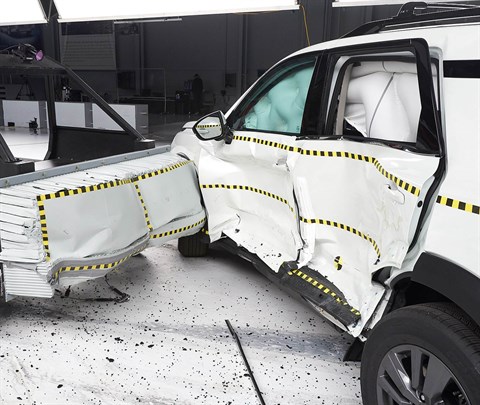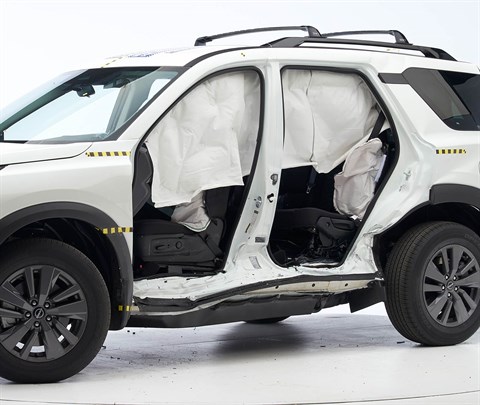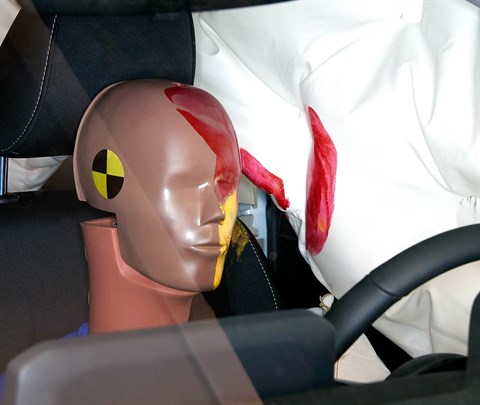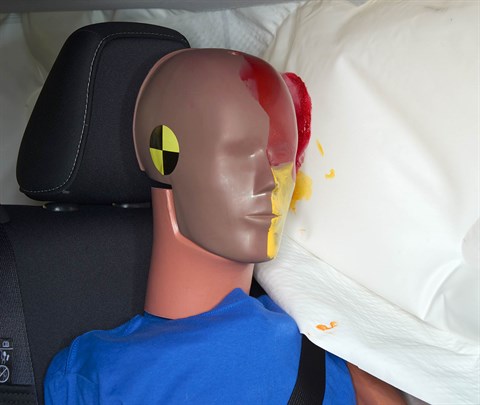Small overlap front
The small overlap front evaluation consists of a driver-side and a passenger-side component. If the results of the two evaluations differ, then the combined small overlap rating is equal to the lower rating.
Driver-side
- Rating applies to 2022-24 models
Tested vehicle: 2022 Nissan Pathfinder S 4-door 4wd
The Nissan Pathfinder and Infiniti QX60 were redesigned for the 2022 model year after a one year absence from the market. Driver-side small overlap frontal ratings are assigned by the Institute based on a test of a 2022 Pathfinder conducted by Nissan.
| Overall driver-side evaluation | |
|---|---|
| Structure and safety cage | |
| Driver injury measures | |
| Head/neck | |
| Chest | |
| Hip/thigh | |
| Lower leg/foot | |
| Driver restraints and dummy kinematics | |
Measures of occupant compartment intrusion on driver side
| Test ID | VTN2111 |
|---|---|
| Lower occupant compartment | |
| Lower hinge pillar max (cm) | 8 |
| Footrest (cm) | 6 |
| Left toepan (cm) | 2 |
| Brake pedal (cm) | 4 |
| Parking brake (cm) | 0 |
| Rocker panel lateral average (cm) | 1 |
| Upper occupant compartment | |
| Steering column | 0 |
| Upper hinge pillar max (cm) | 8 |
| Upper dash (cm) | 7 |
| Lower instrument panel (cm) | 6 |
Driver injury measures
| Test ID | VTN2111 |
|---|---|
| Head | |
| HIC-15 | 109 |
| Peak gs at hard contact | no contact |
| Neck | |
| Tension (kN) | 0.8 |
| Extension bending moment (Nm) | 12 |
| Maximum Nij | 0.16 |
| Chest maximum compression (mm) | 25 |
| Femur (kN) | |
| Left | 0.7 |
| Right | 0.3 |
| Knee displacement (mm) | |
| Left | 1 |
| Right | 2 |
| Knee-thigh-hip injury risk (%) | |
| Left | 0 |
| Right | 0 |
| Maximum tibia index | |
| Left | 0.54 |
| Right | 0.36 |
| Tibia axial force (kN) | |
| Left | 1.8 |
| Right | 0.8 |
| Foot acceleration (g) | |
| Left | 38 |
| Right | 46 |
Passenger-side
- Rating applies to 2022-24 models
Tested vehicle: 2022 Nissan Pathfinder S 4-door 4wd
The Nissan Pathfinder and Infiniti QX60 were redesigned for the 2022 model year after a one year absence from the market. Passenger-side small overlap frontal ratings are assigned by the Institute based on a test of a 2022 Pathfinder conducted by Nissan.
| Overall passenger-side evaluation | |
|---|---|
| Structure and safety cage | |
| Passenger injury measures | |
| Head/neck | |
| Chest | |
| Hip/thigh | |
| Lower leg/foot | |
| Passenger restraints and dummy kinematics | |
| Driver injury measures | |
| Head/neck | |
| Chest | |
| Hip/thigh | |
| Lower leg/foot | |
| Driver restraints and dummy kinematics | |
Measures of occupant compartment intrusion on passenger side
| Test ID | VTP2114 |
|---|---|
| Lower occupant compartment | |
| Lower hinge pillar max (cm) | 12 |
| Footrest (cm) | 9 |
| Right toepan (cm) | 5 |
| Center toepan (cm) | 4 |
| Rocker panel lateral average (cm) | 2 |
| Upper occupant compartment | |
| Center dash (cm) | 3 |
| Upper hinge pillar max (cm) | 8 |
| Upper dash (cm) | 6 |
| Right lower dash (cm) | 4 |
Passenger injury measures
| Test ID | VTP2114 |
|---|---|
| Head | |
| HIC-15 | 95 |
| Peak gs at hard contact | no contact |
| Neck | |
| Tension (kN) | 0.7 |
| Extension bending moment (Nm) | 13 |
| Maximum Nij | 0.19 |
| Chest maximum compression (mm) | 19 |
| Femur (kN) | |
| Left | 0.9 |
| Right | 0.6 |
| Knee displacement (mm) | |
| Left | 1 |
| Right | 2 |
| Knee-thigh-hip injury risk (%) | |
| Left | 0 |
| Right | 0 |
| Maximum tibia index | |
| Left | 0.28 |
| Right | 0.39 |
| Tibia axial force (kN) | |
| Left | 2.3 |
| Right | 1.5 |
| Foot acceleration (g) | |
| Left | 29 |
| Right | 67 |
Driver injury measures
| Test ID | VTP2114 |
|---|---|
| Head | |
| HIC-15 | 27 |
| Peak gs at hard contact | no contact |
| Neck | |
| Tension (kN) | 0.7 |
| Extension bending moment (Nm) | 12 |
| Maximum Nij | 0.15 |
| Chest maximum compression (mm) | 27 |
| Femur (kN) | |
| Left | 0.6 |
| Right | 0.2 |
| Knee displacement (mm) | |
| Left | 1 |
| Right | 1 |
| Knee-thigh-hip injury risk (%) | |
| Left | 0 |
| Right | 0 |
| Maximum tibia index | |
| Left | 0.26 |
| Right | 0.19 |
| Tibia axial force (kN) | |
| Left | 0.9 |
| Right | no data |
| Foot acceleration (g) | |
| Left | 28 |
| Right | 35 |
Moderate overlap front: original test
Rating applies to 2022-24 models
Tested vehicle: 2022 Nissan Pathfinder S 4-door 4wd
The Nissan Pathfinder and Infiniti QX60 were redesigned for the 2022 model year after a one year absence from the market. Moderate overlap frontal ratings are assigned by the Institute based on a test of a 2022 Pathfinder conducted by Nissan.
| Overall evaluation | |
|---|---|
| Structure and safety cage | |
| Driver injury measures | |
| Head/neck | |
| Chest | |
| Leg/foot, left | |
| Leg/foot, right | |
| Driver restraints and dummy kinematics |
Measures of occupant compartment intrusion on driver side
| Test ID | VTF2111 |
|---|---|
| Footwell intrusion | |
| Footrest (cm) | 6 |
| Left (cm) | 8 |
| Center (cm) | 7 |
| Right (cm) | 5 |
| Brake pedal (cm) | 2 |
| Instrument panel rearward movement | |
| Left (cm) | 1 |
| Right (cm) | 1 |
| Steering column movement | |
| Upward (cm) | 3 |
| Rearward (cm) | -3 |
| A-pillar rearward movement (cm) | 1 |
Driver injury measures
| Test ID | VTF2111 |
|---|---|
| Head | |
| HIC-15 | 174 |
| Peak gs at hard contact | no contact |
| Neck | |
| Tension (kN) | 1.4 |
| Extension bending moment (Nm) | 12 |
| Maximum Nij | 0.26 |
| Chest maximum compression (mm) | 29 |
| Legs | |
| Femur force - left (kN) | 0.7 |
| Femur force - right (kN) | 0.8 |
| Knee displacement - left (mm) | 1 |
| Knee displacement - right (mm) | 0 |
| Maximum tibia index - left | 0.29 |
| Maximum tibia index - right | 0.30 |
| Tibia axial force - left (kN) | 2.7 |
| Tibia axial force - right (kN) | 2.0 |
| Foot acceleration (g) | |
| Left | 52 |
| Right | 57 |
Side: updated test
Rating applies to 2022-24 models
Tested vehicle: 2022 Nissan Pathfinder SV 4-door 4wd
The Nissan Pathfinder and Infiniti QX60 were redesigned for the 2022 model year after a one year absence from the market.
| Overall evaluation | |
|---|---|
| Structure and safety cage | |
| Driver injury measures | |
| Head/neck | |
| Torso | |
| Pelvis | |
| Driver head protection | |
| Rear passenger injury measures | |
| Head/neck | |
| Torso | |
| Pelvis | |
| Rear passenger head protection | |

View of the vehicle just after the crash test.

View of the vehicle after the crash with doors removed, showing the side airbags and damage to the occupant compartment.

Smeared greasepaint shows where the driver dummy's head was protected from being hit by hard structures by the side airbags.

Smeared greasepaint shows where the rear passenger dummy’s head was protected by the side airbag.
Measures of occupant compartment intrusion on driver side
| Test ID | CES2210 |
|---|---|
| B-pillar to longitudinal centerline of driver's seat (cm) | -14.5 |
| Negative numbers indicate the amount by which the crush stopped short of the seat centerline. | |
Driver injury measures
| Test ID | CES2210 |
|---|---|
| Head | |
| HIC-15 | 125 |
| Peak gs at hard contact | no contact |
| Neck | |
| Tension (kN) | 1.2 |
| Compression (kN) | 0.1 |
| Shoulder | |
| Lateral deflection (mm) | 16 |
| Lateral force (kN) | 0.7 |
| Torso | |
| Maximum deflection (mm) | 24 |
| Average deflection (mm) | 21 |
| Maximum deflection rate (m/s) | 2.36 |
| Maximum viscous criterion (m/s) | 0.17 |
| Pelvis | |
| Combined force (kN) | 5.2 |
Passenger injury measures
| Test ID | CES2210 |
|---|---|
| Head | |
| HIC-15 | 65 |
| Peak gs at hard contact | no contact |
| Neck | |
| Tension (kN) | 0.4 |
| Compression (kN) | 0.3 |
| Shoulder | |
| Lateral deflection (mm) | 14 |
| Lateral force (kN) | 0.8 |
| Torso | |
| Maximum deflection (mm) | 19 |
| Average deflection (mm) | 16 |
| Maximum deflection rate (m/s) | 1.61 |
| Maximum viscous criterion (m/s) | 0.15 |
| Pelvis | |
| Combined force (kN) | 2.6 |
Headlights
Ratings are given for 2 different headlight variations available on this vehicle.
Trim level(s)
- Autograph trim
| Low-beam headlight type | LED projector |
|---|---|
| High-beam headlight type | LED reflector |
| Curve-adaptive? | Yes |
| High-beam assist? | Yes |
|
Overall rating | |
| Distance at which headlights provide at least 5 lux illumination: | |
Low beams
On the straightaway, visibility was good on both sides of the road. On curves, visibility was good on the sharp left and both right curves and inadequate on the gradual left curve.
The low beams created some glare.
High beams
On the straightaway, visibility was good on the right side of the road and fair on the left side. On curves, visibility was good in all 4 tests.
High-beam assist compensates for some limitations of this vehicle's low beams on the straightaway and on both left curves.
| Trim level(s) |
|
|---|---|
| Low-beam headlight type | LED projector |
| High-beam headlight type | LED reflector |
| Curve-adaptive? | Yes |
| High-beam assist? | Yes |
|
Overall rating Applies to 2022-24 models |
| LOW BEAMS | Average minimum useful illumination distance (5 lux) |
Amount glare exceeded threshold |
|---|---|---|
| Straightaway right edge | 100.0 m | None |
| Straightaway left edge | 60.2 m | None |
| 250m radius right curve, right edge | 86.2 m | 8.9% |
| 250m radius left curve, right edge | 51.5 m | 9.5% |
| 150m radius right curve, right edge | 72.8 m | 6.8% |
| 150m radius left curve, right edge | 59.6 m | 14.7% |
| HIGH BEAMS | Average minimum useful illumination distance (5 lux) |
|---|---|
| Straightaway right edge | 149.4 m |
| Straightaway left edge | 132.9 m |
| 250m radius right curve, right edge | 104.1 m |
| 250m radius left curve, left edge | 78.7 m |
| 150m radius right curve, right edge | 80.7 m |
| 150m radius left curve, left edge | 67.6 m |
Trim level(s)
- Pure trim
- Lux trim
- Sensory trim
| Low-beam headlight type | LED projector |
|---|---|
| High-beam headlight type | LED reflector |
| Curve-adaptive? | No |
| High-beam assist? | Yes |
|
Overall rating | |
| Distance at which headlights provide at least 5 lux illumination: | |
Low beams
On the straightaway, visibility was fair on both sides of the road. On curves, visibility was good on the sharp left and both right curves and inadequate on the gradual left curve.
The low beams created some glare.
High beams
On the straightaway, visibility was good on both sides of the road. On curves, visibility was good in all 4 tests.
High-beam assist compensates for some limitations of this vehicle's low beams on the straightaway and on the gradual left curve.
| Trim level(s) |
|
|---|---|
| Low-beam headlight type | LED projector |
| High-beam headlight type | LED reflector |
| Curve-adaptive? | No |
| High-beam assist? | Yes |
|
Overall rating Applies to 2022-24 models |
| LOW BEAMS | Average minimum useful illumination distance (5 lux) |
Amount glare exceeded threshold |
|---|---|---|
| Straightaway right edge | 91.2 m | None |
| Straightaway left edge | 53.3 m | None |
| 250m radius right curve, right edge | 82.9 m | 46.0% |
| 250m radius left curve, right edge | 46.1 m | None |
| 150m radius right curve, right edge | 64.5 m | 9.2% |
| 150m radius left curve, left edge | 63.4 m | None |
| HIGH BEAMS | Average minimum useful illumination distance (5 lux) |
|---|---|
| Straightaway right edge | 153.4 m |
| Straightaway left edge | 156.7 m |
| 250m radius right curve, right edge | 97.5 m |
| 250m radius left curve, left edge | 87.0 m |
| 150m radius right curve, right edge | 69.8 m |
| 150m radius left curve, left edge | 75.8 m |
Front crash prevention: pedestrian
Child seat anchors
Rating applies to 2022-24 models
| Overall evaluation | + extra LATCH positions |
| Vehicle trim | SV |
| Seat type | cloth |
This vehicle has 3 rear seating positions with complete child seat attachment (LATCH) hardware.
It has 2 additional seating positions with a tether anchor only.
| Overall evaluation | + extra LATCH positions |
| Vehicle trim | SV |
| Seat type | cloth |
| G | Good |
| A | Acceptable |
| M | Marginal |
| P | Poor |
| Seating positions that rely on borrowed lower anchors or have only a tether anchor available are not rated. | |
thether anchor symbol | Tether anchor |
lower anchor symbol | Lower anchors |
| Lower anchor(s) can be borrowed from adjacent positions(s) | |
| No hardware available |
Details by seating position
| 1 | |
|---|---|
| Tether anchor | |
| easy-to-find location | |
| no other hardware could be confused for anchor | |
| Lower anchors | |
| not too deep in seat | |
| not too much force needed to attach | |
| easy to maneuver around anchors | |
| 3 | |
| Tether anchor | |
| easy-to-find location | |
| no other hardware could be confused for anchor | |
| Lower anchors | |
| not too deep in seat | |
| not too much force needed to attach | |
| easy to maneuver around anchors | |
| 4 | |
| Tether anchor | |
| easy-to-find location | |
| no other hardware could be confused for anchor | |
| Lower anchors | |
| none available | |
| 5 | |
| Tether anchor | |
| easy-to-find location | |
| no other hardware could be confused for anchor | |
| Lower anchors | |
| none available | |
| 6 | |
| Tether anchor | |
| easy-to-find location | |
| no other hardware could be confused for anchor | |
| Lower anchors | |
| not too deep in seat | |
| not too much force needed to attach | |
| easy to maneuver around anchors |
Seat position 21
| Lower anchor A | |
|---|---|
| Open access rated | No |
| Depth (cm) | 0-2 |
| Force (lbs) | 5 |
| Clearance angle (degrees) | 88 |
| Lower anchor B | |
| Open access rated | No |
| Depth (cm) | 0-2 |
| Force (lbs) | 7 |
| Clearance angle (degrees) | 85 |
| Tether anchor | |
| Location | Middle seatback |
| Confusing hardware present | Yes |
| Has contrasting label within 3 inches of tether anchor |
Yes |
| Tether anchors can be accessed while seatback is properly positioned for use of LATCH |
Not measured |
Seat position 23
| Lower anchor A | |
|---|---|
| Open access rated | No |
| Depth (cm) | 0-2 |
| Force (lbs) | 7 |
| Clearance angle (degrees) | 81 |
| Lower anchor B | |
| Open access rated | No |
| Depth (cm) | 0-2 |
| Force (lbs) | 5 |
| Clearance angle (degrees) | 80 |
| Tether anchor | |
| Location | Middle seatback |
| Confusing hardware present | Yes |
| Has contrasting label within 3 inches of tether anchor |
Yes |
| Tether anchors can be accessed while seatback is properly positioned for use of LATCH |
Not measured |
Seat position 31
| Lower anchor A | |
|---|---|
| Open access rated | No |
| Depth (cm) | 0-2 |
| Force (lbs) | 12 |
| Clearance angle (degrees) | 82 |
| Lower anchor B | |
| Open access rated | No |
| Depth (cm) | 0-2 |
| Force (lbs) | 18 |
| Clearance angle (degrees) | 81 |
| Tether anchor | |
| Location | Middle seatback |
| Confusing hardware present | Yes |
| Has contrasting label within 3 inches of tether anchor |
Yes |
| Tether anchors can be accessed while seatback is properly positioned for use of LATCH |
Not measured |
Seat position 32
| Lower anchor A | |
|---|---|
| No lower latch for this seat position | |
| Lower anchor B | |
| No lower latch for this seat position | |
| Tether anchor | |
| Location | Middle seatback |
| Confusing hardware present | Yes |
| Has contrasting label within 3 inches of tether anchor |
Yes |
| Tether anchors can be accessed while seatback is properly positioned for use of LATCH |
Not measured |
Seat position 33
| Lower anchor A | |
|---|---|
| No lower latch for this seat position | |
| Lower anchor B | |
| No lower latch for this seat position | |
| Tether anchor | |
| Location | Middle seatback |
| Confusing hardware present | Yes |
| Has contrasting label within 3 inches of tether anchor |
Yes |
| Tether anchors can be accessed while seatback is properly positioned for use of LATCH |
Not measured |
